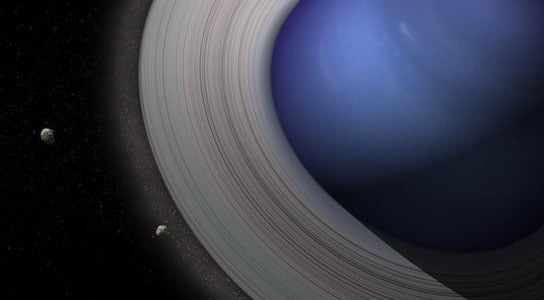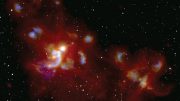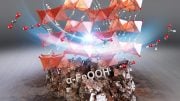
An artist’s view of Neptune with massive rings, giving birth to its satellite system. Credit: Frederic Durillon / animea
Earth’s moon might have emerged from a long-vanished ring system, akin to the rings still encircling Saturn, and this could apply to many of the satellites orbiting other planets. The bulk of the regular satellites in the Solar System might have formed this way, instead of taking shape simultaneously with the planet as a direct result of planet formation.
The scientists published their findings in the journal Science. French astrophysicists suggest that the spreading of rings is fundamental to the birthing process of satellites. The scientists came to this conclusion through theoretical modeling. They found that the moon formation begins at the edge of a planetary ring, where a satellite can start to take shape without being shredded by the gravitational pull of the planet. There, the moonlets coagulate from the ring material before migrating outward. As the ring system continues to produce moonlets, the small objects begin to merge into larger moons, which may in turn merge as they spiral away from the planet.
The standard conception of satellite birth, in which moons condense along with their host planet from a swirling cloud of dust and gas, differs from the idea of moonlet assembly. This seems to work for the largest of satellites, such as the four Galilean moons, but the host of smaller moons circling other planets has so far been considered a by-product of this process.
This new hypothesis could explain a key commonality between the regular satellites of Saturn, Uranus, and Neptune. Moons that are father away from their planets tend to have larger masses. Coalescing moons would grow larger and larger as they drift from the planet and its rings, undergoing progressively more mergers. The end result is a neatly ordered satellite system with smaller moons nearer to the planet and larger ones further out.
Generally, planetary scientists accept that a giant body impacted the newly formed Earth, ejecting a cloud of material that eventually formed the Moon. In this study, the ejecta would have first flattened into a ring around the planet. As time elapsed, the material then coagulated into the Moon. Unlike Saturn’s ring, which would have leaked out enough moonlets to form several moons, Earth’s massive ring would have poured all of its material into one large satellite before it dissipated.
The new theory doesn’t seem to apply to the satellites of Jupiter, which do not obey the same mass-to-distance correlation of the other moon systems. Jupiter was the first planet to form and could have coalesced under different conditions. The fate of the rings is still an open question because the scientists don’t know what happened to the rings of Uranus and Neptune.
Reference: “Formation of Regular Satellites from Ancient Massive Rings in the Solar System” by A. Crida and S. Charnoz, 30 November 2012, Science.
DOI: 10.1126/science.1226477









Be the first to comment on "Saturn-Like Rings May Have Formed Solar System’s Moons"